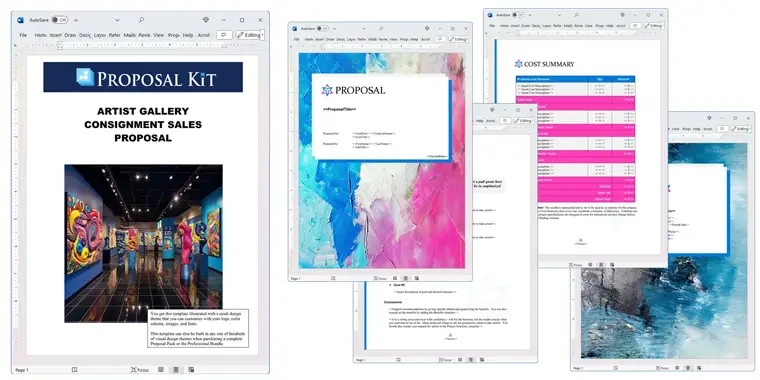How to write your Artist Gallery Consignment Sales Proposal
We include this 12 page layout with every Proposal Pack. If you want this template to have a different visual design theme than the one illustrated here, purchase any Proposal Pack design and create this template using the purchased design theme. This template is included in every Proposal Pack. If you get a Proposal Pack or the Professional, you can also make any variation of this template with different chapters to suit your needs.
We typically include more chapters in the templates than most people will need to give everyone more variety in the chapters they may need. You can trim down a long template by removing pages you do not need or combining multiple chapter topics into one page.
 DOWNLOADABLE, ONE-TIME COST, NO SUBSCRIPTION FEES
DOWNLOADABLE, ONE-TIME COST, NO SUBSCRIPTION FEES![]() View Artist Gallery Sales Sample Proposal
View Artist Gallery Sales Sample Proposal
This sample proposal is based on the same layout as this template and is included in every Proposal Pack. The visual design of the templates will match whichever Proposal Pack design you purchase. To get this template in a different design theme than shown in the sample, purchase any other Proposal Pack design theme and this template will be included.
You can create an editable Word version of this sample in any design theme of your choice including branded to your logo.
 If you need only this template pre-assembled on DVD media order from our Amazon shop.
If you need only this template pre-assembled on DVD media order from our Amazon shop.
You can also create countless variations of this document to suit your needs using the included library of 2200+ chapters if ordering a Proposal Pack or Professional.
 What Our Clients Say
What Our Clients SayProposal Kit helped me create a very professional and detailed quote which landed me one of my biggest clients to date! Fantastic value and an affordable price!"
Polarverse
Related Article
Related Video
Related Templates
- Consignment of Products Sales Proposal
- Procurement and Consignment Services Proposal
- Artist Custom Design Services Proposal
- Fashion Designer Strategic Partnership Proposal
- Auction Services Proposal
- Auction Fundraiser Proposal
- Artist Proposal Template
- Artwork Purchasing Proposal
What's the best way to write your artist gallery consignment sales proposal?
The solution to creating a winning artist gallery consignment sales proposal is using the Proposal Kit. This comprehensive software and template library simplifies proposal creation and includes a line item quoting database system. This system is crucial for creating detailed cost summaries, quotes, estimates, budgets, and other financial documents, making it invaluable for accurately representing your consignment sales details.
Are you tasked with writing a proposal for placing your artwork in a gallery on consignment? If so, consider how a structured and professional approach using Proposal Kit will streamline your efforts and enhance your proposal's impact.
What Types of Projects Are Artist Gallery Consignment Sales Proposals Written For?
Artist gallery consignment sales proposals can serve a wide range of projects. Here are some examples of where such proposals are written:
- Launching a new artist's career in established galleries
- Introducing a seasonal art collection in a local gallery
- Expanding an artist's visibility through regional gallery placements
- Securing a spot for a sculpture series in a national gallery
- Debuting a photography exhibition in a community art center
- Proposing a mixed media installation in a corporate office gallery
- Arranging a traveling art exhibit across multiple galleries
- Featuring a guest artist in a prestigious museum space
- Partnering with a coffee shop to display digital art
- Collaborating with a bookstore to showcase local artists
- Creating a pop-up gallery event in a high-traffic retail area
- Organizing an art fair featuring multiple artists on consignment
- Developing a themed art display for a special event or holiday
- Curating an educational art exhibit at a university gallery
- Promoting an artist collective's work in a cooperative gallery space
- Establishing a virtual gallery tour featuring consigned artworks
- Integrating fine arts into a luxury hotel's decor
- Facilitating an art lease program through a gallery
- Managing rotating art exhibits in a community cultural center
- Collaborating on a charity auction featuring consigned art
Chapters this template is built with
Creating an artist gallery consignment sales proposal requires a tailor-made approach, as no single template fits all scenarios. Proposal Kit's software enables the customization of templates to fit the specific needs of any consignment proposal you might be considering.
Each template and chapter in the Proposal Kit is a customizable Word document. After editing, save your finished proposal as a PDF for easy gallery delivery.
Here's a glimpse at how you can use the diverse templates available:
Cover Letter
Introduce yourself and your art, setting the tone for the proposal.
The cover letter briefly introduces you as an artist, your background, and your intent for the consignment. It also touches upon any past collaborations with galleries and your hopes for this new partnership. This sets the stage for the detailed information that follows in the proposal.
Introduction
Outline the purpose of your proposal and what you aim to achieve with the consignment.
The introduction can explain your goal to expand your reach by displaying your artwork in the gallery. It should highlight your main objectives, such as increasing sales, gaining exposure, or building a long-term relationship with the gallery.
Getting Started
Detail the initial steps you propose to initiate the consignment agreement.
This section can include a timeline of the initial steps, such as meeting to finalize the selection of artworks, delivering the artworks to the gallery, and setting up the display. It may also outline any preparatory work needed from both parties.
Market and Audience
Describe the target market and audience for your artwork.
This chapter should examine the demographics and psychographics of the audience to which your artwork appeals. For example, if your artwork resonates with young professionals or art collectors, clearly define this target market and explain why they would be interested in your pieces.
Gallery
Provide information about the gallery spaces where you wish to display your art.
Include specifics about the gallery, such as its location, size, layout, and any unique features that make it suitable for your artwork. You can also highlight how your art complements the gallery's existing style and how it will be displayed.
Clientele
Discuss who typically buys the art at the gallery and their preferences.
Identify the gallery's typical clientele and describe their purchasing behavior and preferences. This might include collectors, residents, tourists, or corporate buyers. Explain how your artwork fits their buying patterns and appeals to their tastes.
Artists Statement
Share your artistic vision and how your work aligns with the gallery's theme.
The artist's statement should provide insight into your creative process, inspirations, and intentions. Explain how your work aligns with the gallery's theme, mission, or current exhibitions. This helps the gallery understand your artistic perspective and how it fits within their space.
Portfolio
Include images and descriptions of the artworks available for consignment.
Provide high-quality images and detailed descriptions of the artworks you wish to consign. Each piece should include the title, medium, dimensions, and notable features. This helps the gallery visualize your art and understand its significance.
Consignment
Clearly outline the terms of the consignment agreement, including pricing and duration.
Detail the financial and logistical terms of the consignment. This includes the pricing strategy, commission rates, shipment duration, insurance coverage, and other relevant terms. Ensuring clarity in this section helps avoid future misunderstandings.
Use cases for this template
Revitalizing a Gallery's Seasonal Display
Modern Canvas Ventures, a contemporary art gallery, struggled with stagnant seasonal displays that no longer captivated their clientele. Jake, a newly appointed curator, decided to introduce fresh talent to rejuvenate the gallery's offerings. Using the Proposal Kit, Jake created an artist gallery consignment sales proposal. The templates provided a structured approach, enabling him to present a clear and professional pitch to the gallery owners and prospective artists.
Jake detailed how the new consignment pieces would blend with the existing collection, enhancing the gallery's appeal. He included high-quality images and descriptions of the artworks, supported by market analysis, to show the potential increase in foot traffic and sales. By clearly outlining the consignment terms and financial benefits for both parties, Jake secured agreements with several emerging artists. This refresh reinvigorated Modern Canvas Ventures and attracted a new wave of art enthusiasts, boosting seasonal sales and the gallery's reputation.
Rapid Proposal Development for a Gallery Event
Artistic Horizons Co. was on the edge of hosting a significant gallery event, and things were moving at a breakneck pace. Sophia, tasked with preparing an artist gallery consignment sales proposal, had only days to complete it. Under such a tight deadline, she turned to Proposal Kit for assistance. The ready-to-use templates provided a solid framework for her proposal, allowing her to focus on the specific details necessary for the event.
Sophia also leveraged an AI writing tool, which analyzed Artistic Horizons Co.'s website content to generate coherent and relevant text for the proposal. This combination of Proposal Kit's structured templates and the AI tool's adaptive content creation ensured she could quickly compile a comprehensive and professional document. Her proposal highlighted key artists, detailed the event's logistics, and presented the consignment terms. By meeting the deadline with a polished proposal, Sophia ensured the event succeeded, impressing her superiors and the participating artists.
Non-Profit Art Exhibit Proposal
Creative Impact planned a high-profile charity art exhibit to fund community art programs. As the director, Eli faced the challenge of writing an RFP (Request for Proposal) that would attract top-tier galleries to participate. Eli turned to Proposal Kit to create a comprehensive document communicating the exhibit's objectives, benefits, and consignment terms.
Using the Proposal Kit's extensive library of templates, Eli outlined the event's goals, the positive community impact, and the mutual benefits for the galleries involved. He included detailed sections on target audience demographics, marketing plans, and how the consigned artworks would be showcased. The clarity and professionalism of Eli's proposal attracted the attention of several prestigious galleries, securing their participation.
The charity exhibit was a resounding success, drawing significant attendance and achieving its fundraising goals. Eli's well-written proposal, made possible by Proposal Kit, was instrumental in uniting the art community for a cause, showcasing the power of effective proposal writing in driving social impact.
Conclusions and Recommendations
The use of Proposal Kit in creating your artist gallery consignment sales proposal not only streamlines the writing process but also enhances the professionalism and completeness of your final document. The Proposal Kit ensures that your proposal addresses all critical aspects.
Also Known As
This template may also be referred to in different ways or be used in more specialized situations, such as:
- Art Gallery Consignment Agreement Proposal
- Artwork Consignment Submission Proposal
- Gallery Art Sales Pitch
- Fine Art Consignment Proposal
- Artist Representation Offer Document
- Artwork Sales Placement Proposal
- Gallery Exhibition Pitch Document
- Art Consignment Negotiation Paper
- Art Gallery Placement Proposal
- Artist-Gallery Partnership Proposal
Abstract
 Creating a clear and effective artist consignment proposal is essential for securing gallery representation and promoting your artwork directly to potential clients. By using tools like the Proposal Kit, artists can craft professional commission agreements and artist contracts that ensure mutual understanding between the artist and the gallery. This resource helps outline responsibilities, consignment periods, and the artist's share of the sales price. Combine the Proposal Kit with your other important legal documents, such as your consignment agreement, which defines the terms under which the gallery agrees to sell the consigned artwork. Following is a general discussion on things to consider and what you would need to write into the Proposal Kit templates provided.
Creating a clear and effective artist consignment proposal is essential for securing gallery representation and promoting your artwork directly to potential clients. By using tools like the Proposal Kit, artists can craft professional commission agreements and artist contracts that ensure mutual understanding between the artist and the gallery. This resource helps outline responsibilities, consignment periods, and the artist's share of the sales price. Combine the Proposal Kit with your other important legal documents, such as your consignment agreement, which defines the terms under which the gallery agrees to sell the consigned artwork. Following is a general discussion on things to consider and what you would need to write into the Proposal Kit templates provided.
The Proposal Kit can also help simplify the process of drafting contracts, covering aspects like insurance costs, retail price, and the gallery's commission. It ensures that both parties sign the necessary forms and that fiduciary responsibilities are clearly laid out. By addressing different contract types and governing law, artists can protect their interests when their work is sold. The kit helps artists and galleries negotiate terms, such as net price and payment arrangements, making the consignment process less complicated. The Professional edition of Proposal Kit allows you to add your own contracts into the content library allowing you to customize your contract along with your proposal at the same time.
In the competitive art industry, artists frequently need to negotiate contracts that protect their ownership rights and define the scope of their agreements with galleries. The Proposal Kit offers a comprehensive overview of contract types, helping artists understand the responsibilities of each party. By reviewing and filling out these legal documents, artists can ensure that their work is sold under fair terms and that they are paid the agreed-upon amount. Note that your legal agreements and contracts should be reviewed and edited by your attorney. Your contracts can then be incorporated into the Proposal Kit templates. Your proposal and contract are typically separate documents.
 When entering into a consignment agreement, it's important to discuss and agree on details like the consignment period, insurance costs, and what happens in various circumstances, such as if the artwork is damaged or not sold within a certain amount of time. The artist and gallery must both accept and sign the contract to formalize the arrangement. This mutual understanding protects both parties and sets clear expectations.
When entering into a consignment agreement, it's important to discuss and agree on details like the consignment period, insurance costs, and what happens in various circumstances, such as if the artwork is damaged or not sold within a certain amount of time. The artist and gallery must both accept and sign the contract to formalize the arrangement. This mutual understanding protects both parties and sets clear expectations.
The Proposal Kit also helps artists and galleries address responsibilities related to promotion and selling the artwork. It outlines how the gallery will represent the artist's work, the expected efforts in marketing, and any obligations the artist may have in supporting these activities. In instances where exclusive representation is involved, the contract will lay out the terms under which the artist cannot sell their artwork directly or through other venues.
Understanding the financial aspects is crucial. The Proposal Kit assists in detailing how the net price is calculated, how discounts may affect the artist's share, and how funds are to be accounted for. It also covers fiduciary responsibilities, ensuring that the gallery holds money from sales in trust until the artist receives payment. By addressing these points, artists can avoid potential disputes over money and ensure they are paid promptly.
 The consignment agreement also addresses how the artwork will be displayed and whether the gallery will provide frames or other presentation materials. In some instances, the artist may need to loan additional items to enhance the display. It's important to discuss who is responsible for these costs and how they are covered. This ensures that all parties understand their obligations and that there are no unexpected expenses.
The consignment agreement also addresses how the artwork will be displayed and whether the gallery will provide frames or other presentation materials. In some instances, the artist may need to loan additional items to enhance the display. It's important to discuss who is responsible for these costs and how they are covered. This ensures that all parties understand their obligations and that there are no unexpected expenses.
Artists should pay attention to the consignment period's beginning and end dates, ensuring they are comfortable with the duration their artwork will be held by the gallery. They should also consider what happens if the artwork is not sold within that period, including any arrangements for returning the artwork or extending the agreement. Clear communication about these details helps prevent misunderstandings.
Communication is key. The artist and gallery should maintain regular contact to discuss sales progress, client feedback, and any issues that may arise. In the event that the artwork is purchased, the artist should know when they will be paid and how the funds will be transferred. The agreement should specify the payment schedule, whether the artist receives money in advance or after the sale is completed.
 Artists may need to negotiate terms like discounts offered to clients, ensuring that any reduction in the sales price does not unfairly impact the artist's share. Reviewing these details before signing the contract helps prevent misunderstandings later on. It's also advisable for artists to seek legal advice when reviewing contracts to protect their interests.
Artists may need to negotiate terms like discounts offered to clients, ensuring that any reduction in the sales price does not unfairly impact the artist's share. Reviewing these details before signing the contract helps prevent misunderstandings later on. It's also advisable for artists to seek legal advice when reviewing contracts to protect their interests.
Understanding the governing law and any legal obligations is essential. In some cases, the contract may be subject to the laws of a particular city or state, which could affect how disputes are resolved. By taking these steps and utilizing resources like the Proposal Kit, artists can navigate the often complicated process of consignment, focusing on creating art while knowing that the legal aspects are managed effectively.
By using the Proposal Kit, artists can focus on promoting their work to clients and collectors, knowing that the legal and financial details are covered. This resource assists in preparing for various circumstances that may arise, ensuring that both the artist and the gallery understand their obligations. Whether dealing with exclusive representation or specific projects, the Proposal Kit provides valuable advice and resources to help artists navigate consignment agreements. This mutual understanding benefits both the artist and the gallery, leading to a successful partnership that promotes the artist's work and meets the gallery's demand for new and exciting pieces.
Frequently Asked Questions
What should be included in an artist gallery consignment sales proposal?
When creating an artist gallery consignment sales proposal, it's critical to include several key elements to ensure your proposal is comprehensive and persuasive. Start with a cover letter that introduces yourself and your art. Follow this with an introduction that outlines your proposal's purpose and goals. Include a detailed description of your artwork, supported by high-quality images and descriptions in a portfolio section. Provide information about the gallery, such as its location, target clientele, and how your art fits their space. Lastly, clearly outline the consignment terms, including pricing, duration, and any other conditions you propose.
How can I showcase my artwork in the proposal?
An artist gallery consignment sales proposal should showcase your artwork to attract the gallery's interest. In the portfolio section, include high-resolution images of your artwork, along with detailed descriptions. Mention the medium, dimensions, and any unique characteristics of each piece. It's also beneficial to include an artist statement, which provides insight into your creative process and the inspiration behind your work. This narrative can help the gallery understand your artistic vision and how your pieces will resonate with their audience.
What financial details must be included in a consignment proposal?
Financial details are essential to an artist gallery consignment sales proposal, as they help set clear expectations for both parties. Include a pricing structure for each piece of art, specifying how the sale price will be divided between you and the gallery. Outline any additional costs, such as framing, transportation, or insurance, and determine who will cover these expenses. Include a payment schedule detailing when and how you will receive your share of the sales proceeds. This financial clarity will help build trust and ensure a smooth consignment process.
How should I address the gallery's target audience in my proposal?
Understanding and addressing the gallery's target audience is essential in an artist gallery consignment sales proposal. Conduct research to identify the type of clientele the gallery attracts and tailor your proposal to highlight how your artwork appeals to this audience. In the Market and Audience section, describe the demographics, preferences, and buying behaviors of the gallery's visitors. Explain how your artwork aligns with these characteristics and why it will benefit the gallery's offerings. This alignment will increase the likelihood that the gallery will consider your proposal favorably.
How can a Proposal Kit aid in writing an artist gallery consignment sales proposal?
Proposal Kit offers an extensive library of customizable templates that can significantly simplify writing an artist gallery consignment sales proposal. The software includes templates for every vital section, such as the cover letter, introduction, portfolio, and consignment terms, ensuring every significant detail is noticed. Proposal Kit's integrated line item quoting database system also helps you create precise financial summaries, quotes, and budgets. Using Proposal Kit, you can present a professionally structured and polished proposal that stands out to gallery owners and increases your chances of securing a consignment agreement.
20% Off Discount
![]() Add To Cart This Word Template
Add To Cart This Word Template
 Add To Cart Proposal Pack Artsy #10
Add To Cart Proposal Pack Artsy #10
 Add To Cart Proposal Kit Professional
Add To Cart Proposal Kit Professional
 4.7 stars, based on 848 reviews
4.7 stars, based on 848 reviewsProposal Kit chapters used in this template
Cover Letter, Title Page, Table of Contents, Introduction, Getting Started, Market and Audience, Gallery, Clientele, Artists Statement, Portfolio, Consignment, Back Page
You use this proposal for
- General business proposal
- Non-technical proposal
- Product sales proposal
- Business opportunity, partnership proposal
How to create this template with Proposal Pack Wizard
You can create this document using any of the logo-designed Proposal Packs. Pick any Proposal Pack with a logo design theme you like best; they will all work equally well. The Proposal Pack for Any Business is the pack with no extra added logos or colors - designed to be used plain or for you to customize with your logos and graphics.
The Proposal Pack design theme you purchase will determine the visual look of this template. The screenshot above only shows the plain generic design theme.
We include a library of chapters to be assembled based on your needs. All proposals are different and have different needs and goals. We designed Proposal Pack so you can customize the documents to suit your needs.
You will best create this document using the Proposal Pack Wizard - Expert Edition software to select this template and build it in the Proposal Pack logo design theme of your choice along with any desired customizations (such as adding additional chapters, removing unneeded chapters, changing the order of chapters, and importing your company logo). This template outlines a proposal for the described situation. Each user is responsible for typing in the actual content of the provided pages with their information to complete the proposal. Suggestions in the abstract may include features in higher-end packages and are facilitated by the selection of chapter templates to support the narrative of each proposal, which help guide the user in filling in the details.
The Wizard software's AI Writer will write the content of the pages of the template based on details provided for your company, client, project, financial details and other writing instructions. This will provide a personalized version of the template completely written and ready to edit.
Once finished, the AI Writer's Word-to-PowerPoint converter can transform your proposal, business plan, or other business documents into a PowerPoint slideshow. Save time and effort by letting the AI analyze every chapter to condense its content into talking points, visually matching the document, and providing a consistent package of presentation material with the click of a button.
You create this template using the Wizard software with an entire Proposal Pack library and software. We include the Expert Edition of the software in the Proposal Kit Professional. Microsoft Word for Windows is required to use the customizing software. You can also edit Word document templates in other office software such as Word for Mac. We will assist Mac users in assembling complex templates for their first project if they do not have the required platform to run the Wizard software.
How to Build Templates Featured on Proposal Kit Website
Many people find the Proposal Kit website after searching for a specific proposal. Once you've purchased and installed the software, how do you build that template you found in the first place? This video shows you how to build any proposal you see on the Proposal Kit website.
 Ian Lauder has been helping businesses write their proposals and contracts for two decades. Ian is the owner and founder of Proposal Kit, one of the original sources of business proposal and contract software products started in 1997.
Ian Lauder has been helping businesses write their proposals and contracts for two decades. Ian is the owner and founder of Proposal Kit, one of the original sources of business proposal and contract software products started in 1997.By Ian Lauder
 Published by Proposal Kit, Inc.
Published by Proposal Kit, Inc.


 Cart
Cart
 Get 20% off ordering today:
Get 20% off ordering today: 


 Facebook
Facebook YouTube
YouTube Bluesky
Bluesky Search Site
Search Site